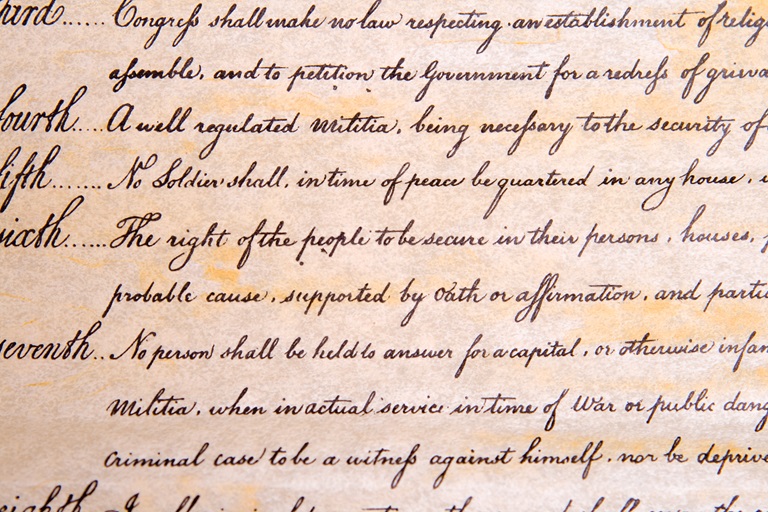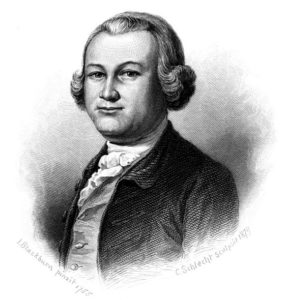Explaining the Fourth Amendment: What counts as persons, houses, papers, and effects?

“The text of the Fourth Amendment reflects its close connection to property,” Justice Antonin Scalia once wrote for the Supreme Court. This vital part of our Constitution secures Americans against unreasonable searches and seizures and is referred to often in popular culture as a privacy right.
But the way it protects privacy is by securing private property. Specifically, the Fourth Amendment guarantees “the right of the people to be secure in their persons, houses, papers, and effects against unreasonable searches and seizures.” In the context of this language, Justice Scalia’s language appears to ring true. But how can old-fashioned private property principles protect Americans from the high-tech threats posed by government surveillance practices today? This article will focus on what “persons,” “houses,” “papers,” and “effects” mean, tackling each in turn, and examining how they stack up against the increasingly sophisticated ways that cities, bureaucrats, police officers, and even municipal code inspectors investigate Americans in the 21st century.
Jump to a section:
————————————————–
Part I: Persons
E.g. bodies, clothes, bags, faces, DNA, behaviors.
The traditional person
“What’s a person?” might seem like a silly question on its face, but it has generated quite a bit of work for constitutional scholars, lawyers, judges, and politicians. The Fourth Amendment protects “the right of the people to be secure in their persons” against “unreasonable searches and seizures.”
Let’s begin with first principles. Humans, obviously, are persons, so we know that it includes our physical bodies. Thus, when a police officer tackles and handcuffs a fleeing robber, he has “seized” the criminal’s “person.” When you’re pulled over by a police officer, you’re clearly not free to leave, so your person has been seized there as well.
For centuries, courts have also held that the “person” extends to the clothes you are wearing and the articles you are carrying with you. I once litigated an assault & battery case where a woman had grabbed a necklace off her husband’s neck. The court—rightfully—ruled it an assault & battery, even though there was no evidence of any hitting or punching, because her husband’s “person” extended to the necklace he was wearing. Consider the line often heard during courtroom dramas where a cop reports that a key piece of evidence was found “on his person.” This is the conventional legal meaning of “person” and it’s the one the courts follow when considering whether a person has been searched or seized by the government in a constitutional sense.
DNA, technology, and personas
During the ancestry craze of the early 2000s, DNA testing became cheap enough that Americans rushed by the thousands to upload a sequenced sample of their saliva into a semi-public database. Since then, DNA databases have been used to catch high-profile criminals, like the Golden State Killer. While the officers involved in that famous arrest didn’t resort to ordering the database to turn over data, the case raised an important question in many concerned legal minds: What if they did? Is our DNA part of our “person” for constitutional purposes?
There’s no question that your skin cells belong to you until you shed them. Same goes for saliva. But what happens when you toss the plastic cup you drank from at a barbecue in the park and a police officer fishes it out of the trash? Is that still your “person,” or merely abandoned property? Notably, there’s no constitutional protection under the Fourth Amendment for abandoned property. The courts generally view the seizure of such items to be valid without much scrutiny. The Supreme Court, for its part, has applied constitutional scrutiny to the question of whether a suspected criminal in custody can have his fingerprints taken or his mouth swabbed for DNA. The first clever criminal to argue that searching a database using DNA violated the Fourth Amendment lost. However, the Court did not flatly rule that people do not have a Fourth Amendment interest in their DNA, so it is conceivable that someone else might yet prevail in such a lawsuit. Because DNA is the biological blueprint for our person, there can be little doubt it is a part of that property interest that comprises each person’s inalienable right to self-ownership.
Indeed, self-ownership is the foundation for the Fourth Amendment’s defense of “persons.” So, if the Fourth Amendment protects our bodies, the clothes we’re wearing, and the DNA inside our bodies—to admittedly varying extents as recognized by the courts—what about our faces?
Most of our phones these days can scan our faces instead of asking for a password. Cameras with sophisticated algorithms can identify unique faces and track the patterns of our movements. The Chinese government has turned this practice into a literal science in a manner that would make even Orwell’s Big Brother cringe. Can the U.S. government do the same? “Maybe” is the best answer we have from the courts today.
In one case litigated by the ACLU against the City of Baltimore, the U.S. Court of Appeals for the Fourth Circuit ruled that a city program to track the movements of its citizens by an integrated program of aerial surveillance and street cameras likely violated the Fourth Amendment because of an argument often referred to as “mosaic theory.”
The mosaic theory draws from a line of Supreme Court cases that focus on whether people have a “reasonable expectation of privacy” against government surveillance, typically when their persons or behaviors are involved. It admits that a person does not have an expectation of privacy in any single piece of data that tells the government where they were or what they were doing at any singular point in time. But, when a surveillance program—like facial recognition or GPS-tracking—collects a larger sample of data, for a more extended period of time, it reveals a great deal of private information that warrants constitutional protection. Lawyers, scholars, and the Supreme Court itself continue to grapple with this mosaic theory.
Because the Court has taken a hard right turn toward property principles and Originalism, it remains to be seen whether and how the theory can be squared with the Fourth Amendment’s enumeration of property interests. But if our “person” includes more than our bodies, there is an argument to be made that it extends to our “persona.” Indeed, intellectual property law has recognized for quite some time that people’s likenesses are their property, as are the fruits of their labor. Most of the proponents of the mosaic theory tend to be liberals, and its detractors are mostly conservatives. This is somewhat ironic when it’s considered that the idea that you have some inalienable property interest in your person and the fruits of your actions and labors—perhaps, in some sense, to include the collection of your movements—is a quite Lockean idea. Perhaps we should call this the “persona” theory rather than the “mosaic” theory…
Part II: Houses
E.g. homes, businesses, outbuildings.
What is a house? It’s obviously a place where you live. But the Fourth Amendment’s text is interpreted based on what its words meant in 1791 when it was ratified. If we consider that “house” was more commonly used as a verb at that time and many non-dwelling buildings even contained the word house (and do still today), that question is not as clear as it may first have appeared. Consider warehouses, Ebenezer Scrooge’s countinghouse, and the poorhouses of the 18th century.
Whenever the Court is unsure of what a word in the Constitution might include, they look to history. Here, it’s very instructive.
Houses are structures
In the 1760s, British customs officials searched and rummaged through people’s houses and businesses in an arbitrary and far-reaching bid to enforce crushing tax laws in desperate—and often politically motivated—attempts to find smuggled goods. They didn’t have specific warrants but relied on “writs of assistance” and “general warrants” that let them search anywhere they wanted without cause—and even force others to help them!
James Otis, a great pre-revolutionary lawyer in Boston, delivered an impassioned five-hour-long argument in Paxton’s Case arguing that these writs and warrants were invalid and unlawful. Importantly, he argued the case on behalf of a collection of Boston merchants whose warehouses and businesses had been searched. The Supreme Court loves citing James Otis’ argument in Paxton’s Case, which John Adams—who was sitting in the courtroom that day—would later refer to as the first step toward American independence. Because this case was the rallying banner for what would eventually become the Fourth Amendment, it only makes sense that the term “houses” would be interpreted to include businesses as well as homes. And indeed it has.
What about regulations?
Today, it seems that there is an increasing number of regulations for just about anything you can conceive of. You want to replace a window in your home? Get a permit. You want to practice massage therapy? Get a license. You want to own a falcon? Get a license. Increasingly. these permits and licenses are issued with strings attached—strings that say your home or business can be searched without a warrant.
So what does the Fourth Amendment say about these searches of “houses”? Well, the Supreme Court clarified in the 1960s that, even though regulatory searches don’t specifically look for evidence of crime, they still have to follow the warrant requirement because you don’t lose your Fourth Amendment rights in property just because you’re using that property for an activity the government has chosen to regulate. For certain heavily regulated industries that pose a danger to society and have a long history of close government supervision, the courts have dispensed with the warrant requirement and replaced it with looser standards.
The exception from the warrant requirement was originally intended to apply to industries like nuclear power, firearms, and underground mines, but unfortunately the regulators have run away with the doctrine, applying it to everything from convenience stores that happen to sell cigarettes (so, most of them) to horse racing and dog training. Much of the expansion of this doctrine took place during a period when the Supreme Court was focused on “privacy interests” rather than property principles and was premised on the theory that your “reasonable expectation of privacy” is diminished in property that’s being used for an activity the government has chosen to regulate.
This theory violates the idea that the Constitution’s protections for liberty are locked in place and superior to mere legislation. With the Supreme Court’s return to evaluating Fourth Amendment cases using property principles rather than privacy interests, it is likely to be pared back in the coming years.
Part III: Papers
When we think about the meaning of “papers,” we might be inclined to think about a physical stack of documents. The Supreme Court has said that business records, diaries, and files of all sorts are “papers.” Digging a bit further into the history of Fourth Amendment, some of the famous lawsuits that took place in England around the time of the American Revolution involved political dissidents who had their houses searched for seditious articles they had printed under pseudonyms that were critical of the King—a big no-no back then! Such documents, of course, are papers within the meaning of the Constitution.
More recently, the Supreme Court ruled in 2015 that the City of Los Angeles couldn’t force hotel owners to turn over their guest registries without a warrant under the guise of business regulation.
The third-party doctrine
From the 1970s until about 2012, the Court used to determine whether someone had standing to challenge a search or seizure of their records based on whether they had a “reasonable expectation of privacy” in the documents’ contents. Personal emails, of course, are protected under this framework. But documents kept by a third-party service-provider, like bank records, were not considered to be sufficiently private under the Fourth Amendment because you accept the risk that the service provider might turn around and share them with someone else. Today, it would be pretty unlikely to consider that your bank will just hand your records to some passerby who wanders into the building and requests them. Nonetheless, this rule—called the “third-party doctrine”—still survives today.
Digital records
Questions increasingly arise over how our 18th-century Bill of Rights applies to new technologies that might not have been conceived by the Founders. Usually, however, there is some analogous technology or practice that can be examined to see how, for example, a politician’s twitter page might be considered a “public forum” akin to a town square under the First Amendment, or an electronic diary entry might be a “paper” within the meaning of the Fourth Amendment. But as we continue to store our papers in “digital” form with electronic service providers like telephone companies, email servicers, and app developers, this raises some weighty questions about whether we retain a “reasonable expectation of privacy” in them—after all, we did share the data with a third party! Here, the Supreme Court has come halfway to answering the question in a way that is unsatisfying to everyone.
In Carpenter v. United States, the Court ruled in 2018 that cell phone users have a “reasonable expectation of privacy” in the location data passively shared with telecommunications companies, but it refused to overrule the older third-party-doctrine cases, leaving that legal rule in a bit of a limbo space. Justice Neil Gorsuch, who wrote a dissenting opinion in Carpenter, had an interesting idea, though. His dissent, which truly reads more like a concurrence, took the position that the third-party doctrine must be overruled as there is no way to square that rule with what the majority opinion said about retaining an expectation of privacy in cell-site records. And he was probably right. After all, one of the principal cases that created the third-party doctrine came out of the 1970s and said that you have no expectation of privacy in the phone numbers you call because those numbers are shared with the switchboard operators who connect different phone lines together (also… passively).
The fascinating germ of Gorsuch’s opinion, however, is rooted in property customs and principles. While lamenting that the attorneys never raised this argument, he discussed how the Court might find that a person has a customary or positive property-related or contractual interest in the records kept by a telephone or other business, and therefore they would have standing to challenge the collection of those records by the government without a warrant. This is similar to the Court’s analysis of whether a police officer exceeded the common-law solicitation license when he deployed a drug dog to a home’s doorstep.
Customs and practices are often helpful in determining whether a search or seizure trespasses on a person, house, paper, or effect, and could prove quite useful in future cases at the Supreme Court—if only one can preserve those arguments and make them effectively.
What we can learn from the dot-com boom
In the early 2000s, the World Wide Web was brand new—at least in the global commercial sense in which we experience the internet today. eBay was a brand-new service and it had many competitors. One particular dispute that arose between eBay and a company called Bidder’s Edge can teach us a lot about how the courts might evaluate Fourth Amendment cases involving digital “papers” today. eBay was only one of several person-to-person selling platforms and the same items would often be posted on multiple websites. Enter Bidder’s Edge.
Bidder’s Edge was a company that aggregated data from several websites like eBay. Bidder Edge programmed its search bots to crawl to websites like eBay, scrape data from them, and bring it back so that the company could tell its users what the current bid was on various websites for a particular item—say, a baseball glove, for example. At that time, internet companies used a standard set of code to instruct the bots sent out by search engines and other websites about what data they were allowed to scrape off. Think of it as a digital “No Trespassing” sign: “You can have this stuff, but go no further.” Bidder’s Edge programmed its bots to ignore that instruction, which was against the customs of the internet at that time.
So what did the court do when eBay sued Bidder’s Edge? It dusted off its property treatise and applied the law of trespass! This is likely the approach Justice Gorsuch, and many other lawyers, judges, and scholars would like to see employed in digital search cases under the Fourth Amendment. It’s certainly a lot more straightforward and predictable in its outcome than asking whether there’s a socially reasonable expectation of privacy… Again, property principles save the day—and protect privacy rights better than a test actually based on privacy.
Part IV: Effects
The courts consider any moveable property to be “effects,” including cars, bags, purses, and other containers. Thus, when a police officer pulls you over, he’s seizing you and your car and all the stuff inside your car. Whether he can search your vehicle or the containers within it turns on one of the Fourth Amendment’s warrant exceptions for vehicles.
But one thing that an adroit reader might have picked up on at this point is the fact that “persons, houses, papers, and effects” doesn’t appear to include land. Does this mean that government agents can brazenly traipse across your front yard and through your forested tracts, hopping fences as it goes? According to the U.S. Supreme Court’s most recent rulings on this question, the answer is “yes.”
Because the Fourth Amendment does not say “possessions” or “property” the way some state constitutions do, the federal courts have interpreted it not to include land under a doctrine called “open fields.” If an officer is standing in an “open field” rather than your house or curtilage—the area immediately surrounding the home—then he’s theoretically not effecting a search or seizure. However, it remains an open question whether officers do engage in searches or seizures under the Fourth Amendment when they, for example, take a soil sample or leave something behind—like a camera. That’s for a couple of reasons.
First, there is a property principle called “trespass on the case,” which applies when someone does something on your property that owes itself to the initial trespass. Consider for a moment that a bandit entered your property without permission, in clear view of your no-trespassing signs, and then dumped toxic waste. The waste he left behind is a trespass on the case. The same rule might apply to the camera (“effect”) that a game warden left on your property when he entered without permission. It might not be your effect in the first instance, but it’s violating your property rights in ways that might just result in a Fourth Amendment event. Second, if the government is taking an animal or sample from your land, then it’s not just searching or seizing your land anymore. Instead, the clump of dirt or the frog it seized is a “chattel” or “effect,” and the common law property principles that exist in the background of the Fourth Amendment and inform its meaning treat those items as your property because they were on your land.
These theories have yet to reach and be considered by the U.S. Supreme Court, but there is little doubt that they will make it there someday soon.
Conclusion
The course of Fourth Amendment case law might be meandering, but it has returned to a more predictable path recently.
The U.S. Supreme Court’s pivot away from privacy interests and toward property interests means that we should examine more closely what Founding-era equivalents to modern “persons, houses, papers, and effects” might have looked like and whether and how they were subject to search in the early days of our Republic. Further, there is reason to be optimistic that this return to Originalism and property principles will better safeguard property and privacy for future generations.




